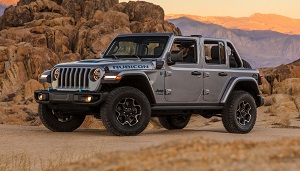Key specs
Jeep Wrangler (Off-road vehicle) Wrangler IV Unlimited (JL) 2020,2021,2022,2023,2024,2025,2026
What is the body type, Jeep Wrangler IV Unlimited (JL) 6.4 Rubicon 392 V8 (470 Hp) 4x4 Selec-Trac TorqueFlite 2020?
Off-road vehicle, 4 Doors, 5 Seats
What is the fuel economy, Jeep Wrangler IV Unlimited (JL) 6.4 Rubicon 392 V8 (470 Hp) 4x4 Selec-Trac TorqueFlite 2020?
16.8 l/100 km 14 US mpg
18.1 l/100 km 13 US mpg
13.8 l/100 km 17.04 US mpg
How much power, Jeep Wrangler IV Unlimited (JL) 6.4 Rubicon 392 V8 (470 Hp) 4x4 Selec-Trac TorqueFlite 2020?
470 Hp @ 6000 rpm.
73.2 Hp/l
What is the engine size, Jeep Wrangler IV Unlimited (JL) 6.4 Rubicon 392 V8 (470 Hp) 4x4 Selec-Trac TorqueFlite 2020?
6424 cm3
392.02 cu. in.
How many cylinders, Jeep Wrangler IV Unlimited (JL) 6.4 Rubicon 392 V8 (470 Hp) 4x4 Selec-Trac TorqueFlite 2020?
8,
V-engine
What is the drivetrain, Jeep Wrangler IV Unlimited (JL) 6.4 Rubicon 392 V8 (470 Hp) 4x4 Selec-Trac TorqueFlite 2020?
All wheel drive (4x4),
How long is this vehicle, Jeep Wrangler IV Unlimited (JL) 6.4 Rubicon 392 V8 (470 Hp) 4x4 Selec-Trac TorqueFlite 2020?
4785 mm
188.39 in.
How wide is the vehicle, Jeep Wrangler IV Unlimited (JL) 6.4 Rubicon 392 V8 (470 Hp) 4x4 Selec-Trac TorqueFlite 2020?
1875 mm
73.82 in.
What is the curb weight, Jeep Wrangler IV Unlimited (JL) 6.4 Rubicon 392 V8 (470 Hp) 4x4 Selec-Trac TorqueFlite 2020?
2315 kg
5103.7 lbs.
Jeep Wrangler (Off-road vehicle) Wrangler IV Unlimited (JL) 2020,2021,2022,2023,2024,2025,2026 Specs
General information
| Brand |
Jeep |
| Model |
Wrangler (Off-road vehicle) |
| Version |
Wrangler IV Unlimited (JL) |
| Engine version |
6.4 Rubicon 392 V8 (470 Hp) 4x4 Selec-Trac TorqueFlite |
| Year production start |
2020 |
| Vehicle type |
Off-road vehicle |
| Horsepower RPM |
470 Hp @ 6000 rpm. |
| Curb weight kg -lbs total |
2315 kg
5103.7 lbs.
|
| Overall length mm - inch |
4785 mm
188.39 in.
|
| Doors |
4 |
Engine specs
| Designation model |
HEMI |
| Cam configuration |
OHV
|
| Engine position and orientation |
Front, Longitudinal |
| Cylinders |
8 |
| Position of cylinders |
V-engine |
| Displacement (liters) |
6424 cm3
392.02 cu. in.
|
| Eng. horsepower RPM |
470 Hp @ 6000 rpm.
|
| Horsepower per litre |
73.2 Hp/l
|
| Weight / horsepower kg/hp - hp/tons |
4.9 kg/Hp
203 Hp/tonne
|
| Weight / torque kg/Nm - Nm/tons |
3.6 kg/Nm, 275.2 Nm/tonne
3.6 kg/Nm
275.2 Nm/tonne
|
| Torque Nm RPM lb-ft RPM |
637 Nm @ 4300 rpm.
469.83 lb.-ft. @ 4300 rpm.
|
| Bore (mm in) |
103.89 mm
4.09 in.
|
| Stroke (mm in) |
94.49 mm
3.72 in.
|
| Fuel delivery system |
Multi-point indirect injection |
| Fuel type |
Petrol (Gasoline) |
| Valvetrain |
2 |
| Engine aspiration |
Naturally aspirated engine |
| Engine oil liters | quarts |
6.3 l
6.66 US qt | 5.54 UK qt
|
| Engine coolant |
11.4 l
12.05 US qt | 10.03 UK qt
|
| Powertrain architecture |
Internal Combustion engine |
| Engine location |
Front, Longitudinal
|
Transmission and Drive system
| Drive configuration |
All wheel drive (4x4)
|
Brakes
| Front brakes |
Ventilated discs |
| Rear brakes |
Ventilated discs |
| Anti-lock brake system |
ABS (Anti-lock braking system) |
Steering
| Steering type |
Cone worm with recirculation balls |
| Turning diameter m - ft |
12 m
39.37 ft.
|
Suspension
| Front suspension |
Coil spring, Rigid axle suspension |
| Rear suspension |
Helical spring, Rigid axle suspension |
Wheels & Tyres
| Wheels size |
285/70 R17
|
| Wheels rims |
7.5J x 17 |
Passenger
| Passengers seats |
5 |
| Trunk space min liter | cu. Ft. |
784 l
27.69 cu. ft.
|
| Trunk space max liter | cu. Ft. |
1909 l
67.42 cu. ft.
|
Dimensions
| Overall length mm - inch |
4785 mm
188.39 in.
|
| Overall width mm -inch |
1875 mm
73.82 in.
|
| Overall height mm -inch |
1892 mm
74.49 in.
|
| Wheelbase mm - inch |
3007 mm
118.39 in.
|
| Track width front mm - inch |
1636 mm
64.41 in.
|
| Track width rear mm - inch |
1636 mm
64.41 in.
|
Weights
| Curb weight kg -lbs total |
2315 kg
5103.7 lbs.
|
| Gross weight kg -lbs total |
2767 kg
6100.19 lbs.
|
| Capacities kg - lbs |
452 kg
996.49 lbs.
|
| Fuel tank liters | gallons |
81 l
21.4 US gal | 17.82 UK gal
|
Fuel economy
| City l/100km - mpg |
18.1 l/100 km
13 US mpg
|
| Highway l/100 km - mpg |
13.8 l/100 km
17.04 US mpg
|
| Combined l/100 km - Mpg |
16.8 l/100 km
14 US mpg
|
| Autonomy km (combined use) |
506 |
Engine type
8 CYLINDER V-Engine
https://www.thecarspec.net/components/engine/8-cylinders-v

